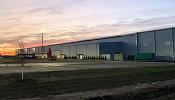- FMA
- The Fabricator
- FABTECH
- Canadian Metalworking
Categories
- Additive Manufacturing
- Aluminum Welding
- Arc Welding
- Assembly and Joining
- Automation and Robotics
- Bending and Forming
- Consumables
- Cutting and Weld Prep
- Electric Vehicles
- En Español
- Finishing
- Hydroforming
- Laser Cutting
- Laser Welding
- Machining
- Manufacturing Software
- Materials Handling
- Metals/Materials
- Oxyfuel Cutting
- Plasma Cutting
- Power Tools
- Punching and Other Holemaking
- Roll Forming
- Safety
- Sawing
- Shearing
- Shop Management
- Testing and Measuring
- Tube and Pipe Fabrication
- Tube and Pipe Production
- Waterjet Cutting
Industry Directory
Webcasts
Podcasts
FAB 40
Advertise
Subscribe
Account Login
Search
Organizing your chaos
Systematic storage for turret punch press tooling
- By Joel Pierson
- January 10, 2006
- Article
- Punching and Other Holemaking
 |
| Image courtesy of Wilson Tool Intl., White Bear Lake, Minn. |
Storage cabinets run the gamut in terms of expense. On one end of the spectrum are expensive cabinets that have large, high-capacity drawers with features such as high-quality slides and drawer lockouts. At the other end of the spectrum are inexpensive cabinets that, although they serve the purpose, are made from light-gauge metals and have mediocre slides and no extra features.
Although these cabinets are very different in form, fit, function, and price, they have something in common: Neither was designed specifically for storing turret punch press tooling.
Fabricators traditionally store punching tools horizontally in various-height drawers to accommodate different tool diameters. A typical tool cabinet might have three drawer heights. These cabinets are advertised as holding x number of A-station tool sets, y number of B-station sets, and so forth.
So how do fabricators store tools in this type of cabinet? We fill the top drawer halfway with A-station rounds, then complete the drawer with A-station rectangles that spill over to the next lower drawer. In that drawer, we fill approximately two-thirds of it with A-station obrounds and complete it with A-station squares. We continue in the third drawer with the rest of the A-station squares and finish it off with A-station D's and some A-station specials.
In the fourth drawer we typically start the same process with B-station tools: B-station rounds, B-station rectangles, B-station obrounds, B-station squares, B-station D's, and B-station specials. This is how we all have done it, but it's not the best way. It's chaotic and lacks continuity and flexibility. The problem is that we have organized tools primarily by station size, which isn't really organization at all. We've been forced to create a poor storage system that conforms to the physical constraints of the cabinets.
Meet Mr. Disorganization and His Good Friend, Mr. Waste
I left the fabricating industry and when I later returned, I discovered something I simply hadn't noticed before: It's difficult to find tools! I dreaded setting up a job because I had to spend too much time finding the tooling. The first thing I had to ask was,"What station is this punch going into?"
Why should I need to know that?
My storage situation wasn't even as good as the one I previously described. I had tools in a rotary cabinet, and in two cabinets with small drawers, and scattered all over a benchtop, and stored in boxes on the shop floor. This was not good.
My employees had been dealing with this for many years, and I didn't realize how much time was being wasted. The turret operator apparently had memorized where all the tools were. However, this didn't get around the fact that he was compensating for my poor management. How many labor dollars did I waste annually?
 |
| Figure 1 Labels are color-coded, affixed magnetically, and arranged in columns and rows to keep tooling organized. |
Finding a Better Way to Store Tooling
I liked the rotary cabinet idea of storing tools vertically but didn't like the lack of flexibility and really didn't like the cost. It occurred to me that maybe vertical storage in drawers might work. I saw another manufacturer try vertical storage, but their system had one of the main problems—it was inflexible in that the drawers accommodated tools for one station only.
I discovered that by using the vertical storage idea, the number of tools that would fit in a drawer was very favorable. Seventy-two A-station tools in one drawer! Thirty-six B-station tools in one drawer! Thirty-six C-station punches, dies, and strippers in one drawer!
Then I started thinking about making each toolholder modular and interchangeable with each other. This would give the system flexibility in that different station sizes could be in the same drawer. In other words, I would group the tooling by shape and then sort it by station size instead of the old way—grouping tooling by station size and then sorting by shape.
This means that if your A-station rounds fill two-thirds of a drawer, you can then continue populating the same drawer with B-station rounds, C-station rounds, and so on. At first I saw a downside because the drawers needed to be around 8 inches high. But then I found that this really was not a downside at all when I started pricing cabinets.
 |
| Figure 2 Open drawers reveal how neatly tooling is organized when stored in this sort of a vertical system. |
I discovered that the cost increases dramatically as a function of the number of drawers ordered with a cabinet. The short-height drawers traditionally used for A-station tools cost about $68, while the tall drawers that I used were only $86. I ended up purchasing two Lista cabinets with four tall drawers and one very short drawer for $860. I purchased plastic trays from the same manufacturer for the very short drawers. I store hardware in them.
The upfront cost turned out to be very favorable, but the real savings would be realized later on.
Not Seeing Red Anymore
I developed a color-coding system to identify tool shapes. In this system red = rounds, blue = rectangles, green = obrounds, black = squares, gray = D's, and yellow = specials. Each drawer face has colored plastic labels arranged in a table format (columns and rows). Each field of the table holds a colored label with a description of each tool in that drawer (see Figure 1). These labels have flexible magnet material fixed to the back so the labels can be rearranged when tools are added.
Imagine this: You're looking for a 0.500-in. round. You start by glancing at the drawers with the red labels on the drawer face. Then you quickly scan across and down until you find the tag labeled 0.500. The coordinate is E-8. Open the drawer, go to location E-8, and pull the tool.
Setup time has become faster than ever mainly because all obstacles have been removed in not only finding tools, but putting them back in the right spot. I can find a tool in 15 seconds. No longer do I dread doing setups. In fact, doing a setup is a pleasure with this tool storage system.
This tool storage system has given me a sense of taking control of the situation and making tool storage the very best it can be. Now I can move on to another area that needs improvement.
Joel Pierson is the owner of Technical Precision Products, 2235 First St. #115, Simi Valley, CA 93065, 805-583-3347, joel@tpproducts.com, www.turrettoolorganizer.com.
About the Author
subscribe now

The Fabricator is North America's leading magazine for the metal forming and fabricating industry. The magazine delivers the news, technical articles, and case histories that enable fabricators to do their jobs more efficiently. The Fabricator has served the industry since 1970.
start your free subscription- Stay connected from anywhere

Easily access valuable industry resources now with full access to the digital edition of The Fabricator.

Easily access valuable industry resources now with full access to the digital edition of The Welder.

Easily access valuable industry resources now with full access to the digital edition of The Tube and Pipe Journal.
- Podcasting
- Podcast:
- The Fabricator Podcast
- Published:
- 05/07/2024
- Running Time:
- 67:38
Patrick Brunken, VP of Addison Machine Engineering, joins The Fabricator Podcast to talk about the tube and pipe...
- Trending Articles
White House considers China tariff increases on materials

A deep dive into a bleeding-edge automation strategy in metal fabrication

A visit to Automate 2024 reveals the future might be now

Majestic Steel Arkansas fully operational

Rivian to expand Illinois facility to manufacture midsized SUV

- Industry Events
Laser Welding Certificate Course
- May 7 - August 6, 2024
- Farmington Hills, IL
World-Class Roll Forming Workshop
- June 5 - 6, 2024
- Louisville, KY
Advanced Laser Application Workshop
- June 25 - 27, 2024
- Novi, MI
Precision Press Brake Certificate Course
- July 31 - August 1, 2024
- Elgin,


























